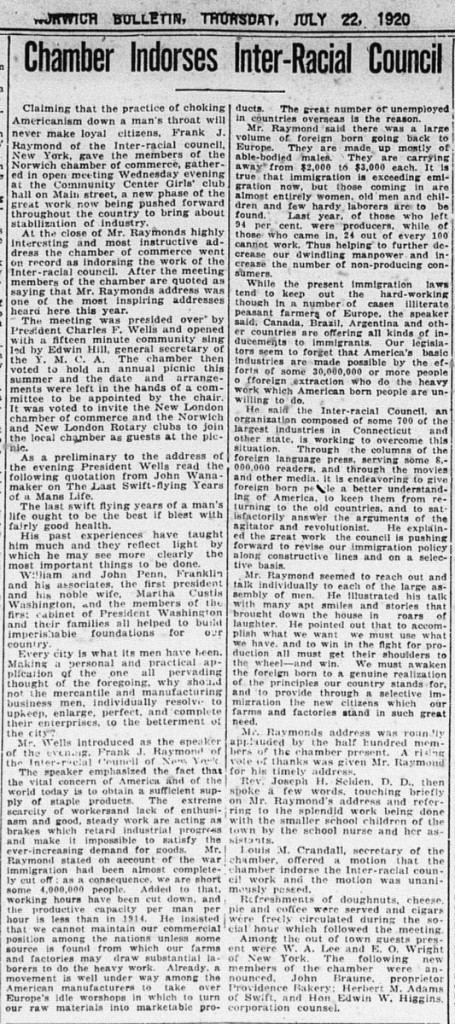Connecticut Business Leaders Fought Nativism in the Post-WWI Period
National immigration policy was highly contested in the years before, during, and just after World War I. Connecticut industry, like U.S. industry in general, saw itself as highly dependent on a massive influx of relatively unskilled foreign workers from southern and eastern Europe. Some highly influential Ivy League figures from New England, on the other hand, saw the “new immigrants,” as the immigrants from southern and eastern Europe were called, as a culturally threatening group that could not be assimilated. A U.S. senator from Massachusetts, Henry Cabot Lodge, gave his support to a group of Harvard graduates who founded an organization called the Immigration Restriction League (IRL). Key members of the IRL were influenced by turn-of-the-century eugenicist and racist anthropological theories. These theories were developed or popularized by Sir Francis Galton, Charles B. Davenport, William Z. Ripley, and Madison Grant, who authored The Passing of the Great Race of 1916 (Higham, pp. 224-225). Lodge and the IRL worked over a period of decades to enact legislation to limit immigration to those of “Nordic” stock. Due in part to their efforts, reports from a federal immigration commission which met from 1907-1910, the so-called Dillingham Commission, codified the notion that the “new immigrants” posed special moral problems for the nation (Pula, p. 65). In 1917, Congress took serious steps to restrict immigration by requiring that those coming to the U.S. pass a literacy test.
Leaders of U.S.industry led by Coleman Du Pont and William H. Barr fought back by setting up the Inter-Racial Council. The Inter-Racial Council, while approving of war-time restrictions against anarchists or others who believed in the overthrow of the U.S. government, was of the opinion that “a policy looking to the exclusion of the immigrant would hamper and curtail our natural development and lead to a world-wide calamity” (Proceedings, p. 8). Because Du Pont, Barr, and others believed that many immigrant workers would return to post-war Europe to enjoy life in the new republics that had replaced pre-war autocratic regimes, these businessmen were fearful that the U.S. labor shortfall would be catatrophic. They also opposed what they deemed crude efforts at “Americanization,” efforts that they believed would drive even greater numbers of immigrants out of the United States.
Those industrialists from Connecticut who attended an April 7, 1920 National Conference on Immigration in New York that was sponsored by the Inter-Racial Council included C.L. Berger of Eastern Malleable Iron Co. of Naugatuck, Robert H. Booth, of the Bridgeport Brass Co., Mr. Derbyshire of the Norwalk Tire and Rubber Co., H.C. Duncan of the Columbia Gramophone Co. of Bridgeport, A.W. Hitchcock of the Underwood Typewriter Co. of Hartford, John Otterson of the Winchester Repeating Arms Co. of New Haven, and Dudley Harmon of the Manufacturers Association of Connecticut. The Inter-Racial Council planned to use the foreign-language press to encourage immigrants to stay in the country and not succumb to the siren song of life in the new post-war republics of Europe, so it is not surprising to see the name of Alexander Schofer of the Bridgeport Hungarian Weekly included in the list of Connecticut attendees.
Soon after the April 7, 1920 Conference, a representative of the Inter-Racial Council appeared before the Norwich Chamber of Commerce. At the end of the meeting, the Chamber voted unanimously to endorse the Council’s work. These industrialists would not prevail; however, as less than a year later, the most restrictive immigration policy in U.S. history to date would be enacted. The Quota Act of 1921 was deeply influenced by the nativists and reduced immigration with a formula designed to assure that the majority of a much smaller pool let into the United States would come from northern Europe.
The Norwich Bulletin from 1910 to 1922 is being digitized as part of the Connecticut Digital Newspaper Project and will be accessible through the Library of Congress site, Chronicling America. The digitization is being funded by the National Digital Newspaper Program, a partnership between the Library of Congress and the National Endowment for the Humanities.
For Further Research
Higham, John. “American Immigration Policy in Historical Perspective,” Law and Contemporary Problems, Vol. 21, No. 2, Immigration, (1956), pp. 213-235. www.jstor.org. Web. May 2, 2014.
Higham, John. Strangers in the Land: Patterns of American Nativism, 1860-1925. New Brunswick, NJ: Rutgers University Press, 1988.
Harvard University Open Collections Program: Immigration Restriction League. 2014.
Pula, James S. “The Progressives, the Immigrant, and the Workplace: Defining Public Perceptions, 1900-1914,” Polish American Studies, Vol. 52, No. 2, (1995), pp. 57-67. www.jstor.org. Web. May 2, 2014.
United States. Immigration Commission (1907-1910). Reports of the Immigration Commission., can be accessed from inside the Connecticut State Library via U.S. Congressional Set, 1817-1980

